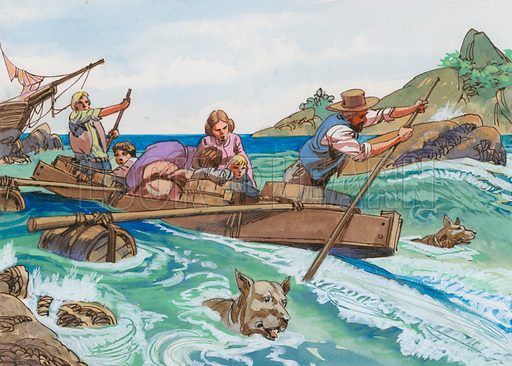Literature, Reviews
Why you should read The Swiss Family Robinson to your kids
For decades, the great literary scholar Anthony Esolen has been urging people to return to the classics. The canon of literature produced by Christendom may have been largely abandoned, but is still widely available to anyone seeking to claim their rightful inheritance. These books, Esolen once noted, “are the great unused artillery of the culture wars.” One of those much-needed classics was penned by a Reformed rector to teach his sons the virtues of self-reliance and moral character and the practices of family prayer, family worship, and keeping the Lord’s Day—practices in desperate need of revival. Johann Wyss’s adventure story would become one of the most popular books of all time.
The German first edition of The Swiss Family Robinson was published in 1812 to immediate acclaim. The story of a Swiss couple and their four sons shipwrecked on an exotic island on their way to Port Jackson, Australia in a vicious storm and their many subsequent adventures was promptly translated into English in 1814 and French in 1816. The great novelist Jules Verne was so obsessed with the novel that he wrote two sequels, Their Island Home and The Castaways of the Flag, published in 1900; the most recent attempt at a sequel was published over a century later in 2015. To date, more than 200 English versions of The Swiss Family Robinson have been published.
Even though The Swiss Family Robinson has remained wildly popular for generations and spawned several films and countless abridged editions, we know surprisingly little about its author, Johann David Wyss (1743-1818). He was born and died in Bern, Switzerland, and as a young adult he served as a military chaplain in Italy. He gained a reputation as a skilled linguist (speaking four languages) and would eventually become the rector of Bern’s great Reformed Protestant Cathedral. He was a devoted family man who enjoyed hiking, hunting, fishing, and engaging in amateur naturalism with his four sons. He and his wife also enjoyed reading and discussing books with the family—including adventure stories.
One of those books was Daniel Defoe’s great 1719 novel Robinson Crusoe, and Wyss decided he wanted to write a story that would be both adventurous and instructive for his own children. The story models good husbandry and farming, the importance of physical fitness and self-reliance—as Mr. Robinson notes while observing his boys at their exercises: “No man can be really courageous and self-reliant without an inward consciousness of physical power and capability.” Strength and agility were necessary on an island so filled with strange creatures—the story is filled with detailed descriptions of flora and fauna. Even the quagga, a subspecies of plains zebra hunted to extinction within seven decades of the book’s publication, is mentioned.
The book, fittingly, was a family project. Wyss had his sons take turns telling stories and wrote them down. Eventually these were turned into a book, with unpublished illustrations provided by his son Johann Emmanuel. His son Johann Rudolf, who later penned the Swiss national anthem, edited and submitted it for publication. Johann Rudolf returned to the book and published a longer version in 1827. The Robinson family was clearly modelled after Wyss’s own, with the discussions of nature and wildlife reflecting the family’s own interests. Wyss wanted to use an adventure story to teach young readers both virtue and natural history, and the sheer variety of species he placed on a single island was both geographically impossible but educationally convenient.
For the post-Christian youth of today, this story is written in something approaching a foreign language. The Swiss Family Robinson, like so many great literary works of its time, is rooted in presuppositions—that God exists, that He hears people, and that Christianity is true. It begins with the father offering up a fervent prayer for deliverance as their ship is battered by a storm, and prayer is central throughout the book. The Robinsons prayed like they breathed—it was an essential part of how they lived. Prayer was both spontaneous and deliberate; formal and informal.
The first morning after the family is stranded, for example, the father reminds them that before they go exploring, they must bend their knees in morning prayer. “We are only too ready, amid the cares and pleasures of this life, to forget the God to whom we owe all things,” he observes. Every night, the family closes with devotions. When Mr. Robinson struggles with their plight, he “would not communicate the sense of depression to my family, but, turning in prayer to the Almighty Father, laid my trouble before Him, with never-failing renewal of strength and hope.”
READ THE REST OF THIS COLUMN AT THE EUROPEAN CONSERVATIVE








